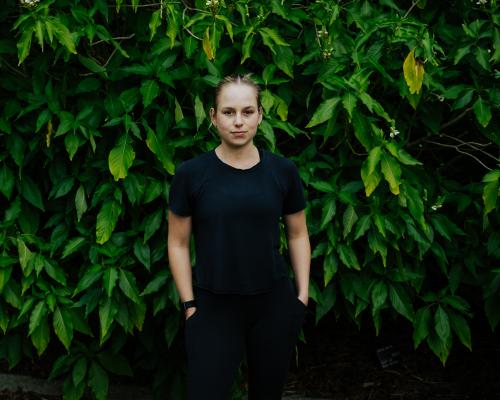
What would become a decade-long battle that nearly claimed her life started out “quite innocently” for Portia Michau.
“I wanted to be the ‘healthiest’ version of me I could be and it stumbled from there,” she says.
At 14, she began to exercise and control her diet in what she says was an attempt to “fix” her body, which had changed “quite dramatically” during puberty.
By 18, she was exercising multiple times a day and hyperfixated on her diet. Her period stopped, she couldn’t sleep and she was always cold. Socialising became harder and eventually stopped altogether.
Then, her heart began to slow, and she was admitted to the cardiac ward at Monash hospital in Melbourne’s south-east.
“There was actually nothing technically wrong with my heart,” Michau says. “It was just the result of being so deficient in energy.”
For a month, she was confined to a hospital bed. Michau says while doctors were treating the “side-effect” of her eating disorder, the cause was largely ignored.
“I was basically told: ‘eat more,’” she says. “Eating was my biggest fear. There was no support or understanding of that.”
Now, two new Victorian government-funded programs – one a world-first, the other nation-leading – are aiming to change how the public health system responds to one of the deadliest, yet most neglected, mental health conditions.
The Eating Disorders Intensive at Home program began accepting referrals in February, while Ngamai Wilam, the state’s first public residential eating disorder centre, opened three months later. Both are run by Alfred Health.
“There won’t be other places doing what we are doing here – both in the public or private space – probably anywhere in the world,” says Dr Paul Denborough, the director of Alfred Health’s infant, child and youth mental health and wellbeing service.
Early intervention is crucial
Denborough oversees the at-home eating disorder program, which is a world-first early intervention service, largely focused on 14- to 16-year-olds – the age when anorexia most commonly emerges.
Though rare, the program has received referrals for children as young as seven, Denborough says.
He says that because “thinness is valued in western cultures”, there isn’t “enough anxiety” when early signs appear, such as worrying about weight or diet. As a result, parents are generally “a few months behind” when it gets serious.
But he believes eating disorders are “completely curable” if help comes fast.
Denborough describes the at-home program as a “one-stop shop”, delivered by a team of psychiatrists, dieticians, nurses, social workers and lived experience support staff – people who’ve recovered from eating disorders, as well as relatives.
The model, adapted from Finland’s Open Dialogue approach to mental health, involves the young person’s entire support network. Rachel Barbara-May, who works alongside Denborough on the program, says responsiveness is a key element.
“There’s no waitlist across our entire service,” she says. “We’re often in contact within 48 hours of a referral, we provide support over the phone or in person daily. In one case, a family were having a really hard time with their young person, so we were at their home in 20 minutes.”
For adults needing more intensive care, there’s Ngamai Wilam. From the street, it looks like a new, modern home – not out of place in leafy Armadale. Inside, it’s a thoughtfully designed 12-bedroom treatment centre.
Participation is voluntary, with patients committing to undergoing weight restoration – three meals and three snacks daily, each followed by support. There’s also group and one-on-one therapy.
This level of care was previously only available in hospital. But here, patients can leave the building, stay in part-time work or study and keep parts of their daily routine going. Six similar centres are planned across Australia, thanks to federal funding.
Dr Jenny Babb, who leads Ngamai Wilam and directs statewide women’s mental health services at Alfred Health, says the shift is overdue.
“We have this history of paternalism in this space – that we do things to people,” she says. “But it’s really hard to see how that’s going to then cause behavioural change.”
On the rise, yet underfunded
In 2022, the Butterfly Foundation estimated eating disorders affected about 4% of Australians, or more than 1 million people, with about two-thirds of them women and girls.
But the real figure could be higher – Butterfly’s research estimates 17% of the population either have an eating disorder or show more than three symptoms of disordered eating.
In Victoria, eating disorder presentations rose by 10% between 2008 and 2018, according to evidence presented at the state’s mental health royal commission. It climbed further during the pandemic.
Sign up: AU Breaking News email
Yet they remain significantly underfunded. In Australia, eating disorders receive the lowest share of mental health research funding, despite anorexia having the highest mortality rate of any mental illness – in part due to starvation-related health problems but more due to high suicide rates.
“The level of distress is quite unique because it’s always there,” Babb says.
Part of the problem, Denborough says, is structural. Eating disorders have historically been separated from other mental illnesses, which left them siloed.
There’s also been a lack of political will to address it.
“Eating disorders haven’t always been treated with the seriousness they deserve,” says Victoria’s mental health minister, Ingrid Stitt. “I’ve got no doubt there must be a gendered reason behind some of this, because there’s an overrepresentation of young women.”
In late 2024, Stitt released Victoria’s first statewide eating disorder strategy in a decade. Backed by $31m in funding, it focuses on early intervention, improving community-based care and research and data collection.
The strategy also calls for “media and social media standards”. Stitt is hopeful the federal government’s move to ban under-16s from using social media will help.
“There’s a clear link between excessive social media use and body dissatisfaction among young people,” she says.
While the body-positivity movement gained traction in the 2010s, the pendulum has swung back in recent years. Thinness is again being held up as an ideal, fuelled in part by the rise of weight-loss drugs and the popularity of #SkinnyTok content (a hashtag recently blocked by TikTok for promoting unhealthy weight loss).
“We’ve come through the gastric surgery era, and now drugs like Ozempic are the next wave,” Babb says.
After Michau’s stay in the cardiac ward, she spent eight weeks in a hospital-based eating disorder treatment. She believes either of these new programs would’ve led her to seek help earlier.
“I had to give up my whole life for recovery,” she says. “If these options had been available maybe it wouldn’t have been such a life-altering thing. I could’ve had gone to uni, had a job.”
Michau is now a wellness coach and works with young women to develop a healthy relationship with food and exercise.
“I’ve learned that movement doesn’t need to be about weight loss or punishment or making up for something, it can be a really beautiful way to celebrate who you are,” she says.
• In Australia, the Butterfly Foundation is at 1800 33 4673. In the UK, Beat can be contacted on 0808-801-0677. In the US, help is available at nationaleatingdisorders.org or by calling ANAD’s eating disorders hotline at 800-375-7767. Other international helplines can be found at Eating Disorder Hope







